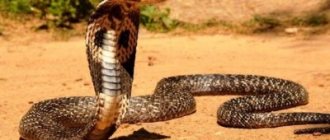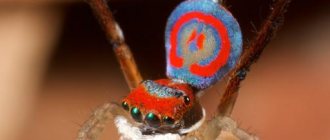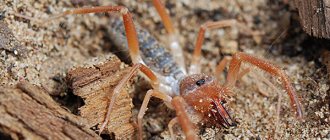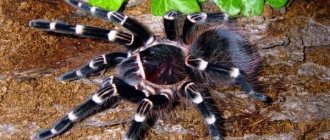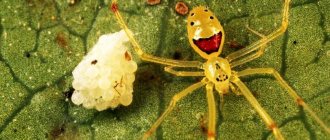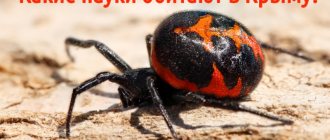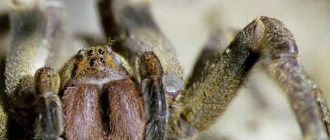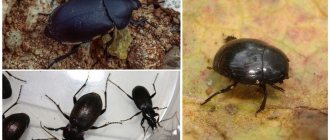Dangerous spiders that are found in Crimea
Let's look at what arthropods you should be wary of and what to do if you are bitten by a poisonous spider.
Tarantula
Tarantula is the largest representative of arachnids in Crimea. Its dimensions are more than 3 cm in length. Inhabits the arid regions of the steppe part of the Crimean Peninsula. During hot weather, it hides in a hole, the depth of which can reach half a meter. The Crimean tarantula feeds on beetles, insects, caterpillars, and grasshoppers. The tarantula does not attack first, but, on the contrary, hides in a hole, barely catching the vibration of the earth.
Note : a tarantula bite is not dangerous to human life. The sensation is comparable to a wasp sting. The bite site swells, but over time the swelling goes away.
Salpuga (phalanx spider)
The salpuga spider is not inferior in size to the tarantula. Its yellowish-gray color and long legs are terrifying. Lives in the foothills and on the South Coast.
Important ! The danger comes from a large spider that can bite through the skin. A small spider cannot do this.
A salpuga bite causes a burning pain that soon goes away. The arthropod is not poisonous. The main danger lies in the fact that the spider's chelicerae store the remains of its diet - rotting particles of the flesh of its victims. When bitten, they enter the bloodstream and can cause infection and inflammation of the bite site.
Karakut (black widow)
The most dangerous spider of all that lives in Crimea is, of course, the Black Widow - a spider whose habitat is tall, dry grass. The male karakuta grows up to 7 mm, the female is slightly larger. A distinctive feature is four red dots on the back. After mating, the female devours the male, hence the name.
Need to know! A black widow's bite can be fatal. The venom of this arthropod is 15 times stronger than the venom of a rattlesnake. However, when biting, the spider does not inject the entire dose into the victim’s body, but only a part. Thanks to this, the victim manages to survive.
Bite symptoms:
- increasing pain with a growing effect
- dizziness
- numbness of the limbs
- panic fear
- vomit
- convulsions.
What to do if you are bitten?
No later than two minutes after the bite, you need to burn this place with a hot match. This must be done quickly, before the poison spreads throughout the body.
Agryope spider
This spider grows up to 1.5 cm. Because of its color, it is often called the wasp spider or zebra spider.
Agriopa's venom is not life-threatening , but the bite itself can cause a lot of trouble. Allergy sufferers and people with weakened immune systems can especially suffer from it. In some cases, an abscess may form at the site of the bite, accompanied by further tissue necrosis.
Symptoms of an agriope bite:
- sharp burning pain, like a bee sting
- immediate swelling and redness of the skin area
What to do?
No first aid required. Particular attention should be paid to children and allergy sufferers. If you feel worse, you should seek medical help.
This is interesting: Recreation center "Parus" in Popovka (Crimea): official website, reviews, description
Why is a karakurt bite dangerous?
The neurotoxic venom begins to act almost at the moment of the bite. In this case, the place where the skin is damaged and the poison enters the body quickly turns red and hurts. As a result of damage to the nervous system, severe muscle pain appears. It starts with the calf and abdominal muscles. After 10–20 minutes it covers the entire body. After this, severe dizziness develops, breathing becomes difficult, profuse sweating, trembling, shortness of breath, nausea, etc. occur. If medical assistance is delayed, the condition is aggravated by mental reactions, such as depression or painful agitation. In especially severe cases, clouding of consciousness and delirium occurs. Antikarakurt serum is required for treatment. However, there are other drug treatments for black widow poisoning, but they are less effective.
It's not just people who die from black widow bites. They are especially dangerous for camels, horses and cows. Sheep, goats and pigs are practically not affected by spider venom.
Karakurt - a poisonous inhabitant of Crimea
The karakurt is recognized as the most dangerous representative of spiders. It feeds on insects. Favorite habitats are rodent burrows, from which the spider easily expels the inhabitants. Even if the mouse decides to resist the karakurt, it instantly dies from its bite. Also settles between stones, in rock cracks. It places its trapping nets in the grass, in the steppes and even in summer cottages. From Turkic the name “karakurt” is literally translated as “black worm”; a photo of the dangerous spider of Crimea is presented above.
What does the most dangerous spider in Crimea look like:
- Sexually mature females are rich black in color with a glossy sheen, up to 2 cm long.
- The length of males does not exceed 7-8 mm.
- Juveniles and males have 13 red spots on the abdomen. Sometimes they are framed with a white border.
- Two pairs of eyes help to navigate well during the day and at night.
- Random networks are located mainly near the ground.
Karakurts are very prolific. Periodically, at intervals of 10-12 or 25 years, there is a massive outbreak of population growth. They spend winter time in cocoons, several of which are suspended in nests. In mid-spring, the young generation appears and is carried away on the web by the wind. At the end of June, having become sexually mature, females and males look for shaded places and weave nets for mating.
Interesting! Due to the bloodthirstiness of the female during mating, the karakurt is also called a black widow. The mating games of the female are very peculiar - at the end of the process, she eats the male. The female has an excellent appetite: her network for mating can simultaneously contain up to 5 candidates.
The males' life cycle ends in mid-July. After mating, females look for new places, weave a network and lay offspring. After the last laying of eggs they die.
How karakurts bite
Representatives of the black widow genus are not characterized by aggressiveness towards humans. Only if they sense danger do they defend their lair - only in emergency cases are they able to attack people. Most often, this type of spider in Crimea bites accidentally. This is due to the peculiarity of their reflexes. When pressed on the abdomen, they release poison; for this reason, a spider crawling on the body should not be slammed, but carefully thrown off.
The greatest threat to humans is the female karakurt, while males, due to their small size, are not able to bite through human skin
On a note! After picnics or trips to nature, it is recommended to inspect things, as spiders can easily get into them. It is best to walk through thickets of grass in closed high shoes, and to work in summer cottages and fields with gloves.
The concentration of poisonous components in karakurts is 15 times higher than in a rattlesnake. This feature is due to the fact that spiders wage a constant fight against rodents and other small mammals, and to neutralize them a strong poison is needed. In humans, the probability of death after a bite is 2-4%. The poison has a neuroparalytic effect.
Symptoms of a karakurt bite:
- the appearance of severe burning pain, which intensifies and spreads throughout the body within 15 minutes;
- difficulty breathing;
- dizziness, possible bluish discoloration of the skin on the face;
- disturbances of heart rhythm and kidney function;
- cramps, muscle spasms in the abdominal area;
- depressive state, the appearance of a feeling of irresistible melancholy and fear of death.
On a note! The sensations of the bite field depend on the person’s pain threshold. There are cases when people in a dream did not notice at all that they had been bitten by a spider.
What to do if you are bitten by a karakurt:
- The most effective way to eliminate the consequences of a bite from the most dangerous spider in Crimea is to administer a serum. However, it is not always available at medical centers. In its absence, an intravenous injection of potassium manganese or calcium gluconate is administered. The need for a second injection is determined by the condition of the victim.
- In the field, the cauterization method, which was developed by Marikovsky, is used. Immediately after the bite, in order to neutralize the effect of the poison, 3 matches are applied to the wound (heads to the wound), and the fourth is set on fire. High temperature destroys the protein structure of the poison and thereby avoids poisoning the body.
Is the wasp spider poisonous or not?
The arthropod has poisonous glands that produce a toxic substance. When it enters the victim's body, it causes muscle spasm and immobilization. The poisonous brunette is not distinguished by its aggressive disposition and does not attack unnecessarily. For humans, its presence nearby does not pose a danger. However, if the argiope feels a threat to his own life, the attack will follow.
Due to its unusual color, wasp spiders are kept at home as pets. They live in specially equipped aquariums and feed on insects. Feeding should be done every other day. up to 1.5 years.
The karakurt spider is one of the most dangerous creatures on earth. Despite its small size and non-threatening appearance, the karakurt's venom is 15 times stronger than that of a rattlesnake and 50 times stronger than that of a tarantula. For a horse or camel, a karakurt bite is often fatal.
The karakurt spider is one of the most dangerous creatures on earth
Without prompt medical intervention and professional help, a meeting with a person can also result in death, although such cases are extremely rare. The black spider evokes mystical associations due to the presence of 13 bright red spots on the body and cannibal family traditions. Kalmyk shamans use a dangerous creature in some rituals. There is a common belief that karakurts live only in deserts and do not pose a danger to residents of the central and even southern steppe and forest regions, but this is not true. Recently, the migration of biting “robbers” to the north has been obvious, and climate warming has led to the fact that karakurts are recorded in regions where they have never been observed before.
The poisonous karakurt spider belongs to the order of spiders of the family of web spiders from the genus of black widows. Translated from the Turkic language, the name is literally translated as a black worm. The Latin name Latrodectus tredecimguttatus reflects the external characteristics - 13 points on the back and the essence of the spider (biting robber). Like the karakurt, which is sometimes called the steppe spider? In terms of size, the spider belongs to the medium arachnids. The size of the male is 4-7 mm, the female karakurt is 2-3 times larger and can reach 20 mm. The body of the eight-legged spider is black, with a pronounced abdomen. Both males and females have red spots or dots on the upper side of the abdomen. On the lower part of the abdomen a clear scarlet pattern is visible, similar to the outline of an hourglass. The spot on the abdomen often has a snow-white halo. Adults (males) can be completely black. Karakurt is a predator; it feeds on insects, which it uses a web to catch.
Despite its small size and non-threatening appearance, the karakurt's venom is 15 times stronger than that of a rattlesnake and 50 times stronger than that of a tarantula.
White karakurt, also related to web spiders, has a white or yellowish color. There is no hourglass pattern or spots on the body, but there are 4 indentations forming a rectangle. White spiders are much less poisonous, their bite is not dangerous to people, although the venom of the white karakurt is similar in its toxicological properties and effects on the human body and animals to the venom of the black widow. White karakurts can be found in Russia and neighboring countries, but the main habitat is located further south - in North Africa, the Middle East, and also in Central Asia
Let's focus on the black widow karakurt as the most dangerous representative of the internet, which you can meet at domestic resorts
Karakurts are distinguished by their fertility; in the southern regions there are periodic surges in the birth rate, which entail an increase in the number of casualties among people and loss of livestock. Poisonous spiders in Kazakhstan and Crimea attack dozens of people every year, but serious consequences occur extremely rarely. The female lays more than 1,000 eggs per year, which are placed in a protective cocoon. The newly born spiders continue to live inside the cocoon and emerge from there only next spring. Puberty occurs 2-3 months after the spiderlings leave their original home. Eggs are laid in holes on the ground or in rodent burrows. Fertilization occurs during the hottest months of summer. After mating, the female karakurt eats the male, although there are exceptions - for unknown reasons, the female can either destroy the male before mating or leave him alive after fertilization.
Tarantula. Crimean tarantula. Tarantula bite, help with a bite.
Tarantula is the common name for several species of large spiders belonging to the wolf spider family. Tarantula is an invertebrate animal. Its body, consisting of two parts - the cephalothorax and abdomen, is covered with small hairs. Tarantulas are the largest spiders living in Ukraine, the size of large individuals reaches 4 cm. The spider is colored brown-gray-black, and those that have not shed for a long time have a red tint. Very often, other large spiders, such as tarantulas, are mistakenly called “tarantulas.”
Read more…
The most unusual species
Nature sometimes puts spiders in such bizarre forms that you just wonder where so much imagination comes from. Here are just a few such examples.
- Spider-Peacock. It is distinguished primarily by its bright color, reminiscent of a peacock feather. The size of the individual is limited to five millimeters, so it is not easy to see. Only males have this color.
- Crab spider. Externally it resembles a crab. In addition, this unique creature can move, just like a crab, from side to side and back to front. And the ability to change color makes it invisible against the background of its habitat.
- Dolomedes. Another name for this spider is “fish”, since it lives near bodies of water and feeds on small fish, which are no larger in size than itself.
- Spider is a whip. This creature rather resembles a thin twig and is completely unlike its fellows. The species was named Colubrinus, which means serpentine. Nature created it this way for camouflage. Such a predator sits in the web, and the prey thinks that the twigs are stuck to the web and is not afraid of it at all.
Let's put a cross: biting cross spiders
In many spiders, females are dangerous to humans - they are significantly larger than males (they are simply unable to bite through the skin). This is also true for cross spiders. There are several varieties of them (common Araneus diadematus, diamond-shaped), but they are all similar in habitat, appearance and influence on people.
Krestoviki weave trapping nets and hang them between trees and bush branches. All of them are not rare; many have seen them. A distinctive feature is a light pattern like a cross on the abdomen. These are large spiders - a female, hanging with her legs spread out in the web, can reach 4 cm in “diameter”. They feed on insects.
A cross bite is not dangerous, but can be painful and cause significant local inflammation (up to and including slight necrosis of the tissue around the wound). No special treatment is needed - just lubricate the area with anti-inflammatory agents. If the manifestation is severe, you can take an antiallergen.
This is interesting: Mount Perchem in Sudak (Crimea): photo, how to get there, on the map, description
Types of spiders, names and photographs
Scientists have described more than 42,000 species of spiders. About 2,900 varieties are known in the CIS countries. Let's consider several varieties:
Blue-green tarantula (Chromatopelma cyaneopubescens)
one of the most spectacular and beautifully colored spiders. The tarantula's abdomen is red-orange, its limbs are bright blue, and its carapace is green. The size of the tarantula is 6-7 cm, with a leg span of up to 15 cm. The spider’s homeland is Venezuela, but this spider is found in Asian countries and on the African continent.
Despite belonging to tarantulas, this type of spider does not bite, but only throws special hairs located on the abdomen, and only in case of severe danger.
The hairs are not dangerous for humans, but they cause minor burns on the skin, similar in effect to nettle burns. Surprisingly, female chromatopelma are long-lived compared to males: the lifespan of a female spider is 10-12 years, while males live only 2-3 years.
Flower spider (Misumena vatia)
Belongs to the family of side-walking spiders (Thomisidae). Color varies from completely white to bright lemon, pink or greenish. Male spiders are small, 4-5 mm long, females reach sizes of 1-1.2 cm.
The species of flower spiders is distributed throughout European territory (excluding Iceland), and is found in the USA, Japan, and Alaska. The spider lives in open areas with an abundance of flowering herbs, as it feeds on the juices of butterflies and bees caught in its “embraces.”
Grammostola Pulchra
A species of tarantula spider that naturally lives only in Uruguay and the southern regions of Brazil. A rather massive spider, reaching a size of 8-11 cm, with a dark color and a characteristic “metallic” sheen of hairs.
In nature, it prefers to live among the roots of plants, but almost never digs its own burrows. Pulhra often becomes a pet among connoisseurs of exotic pets.
Argiope bruennichi or spider wasp (Argiope bruennichi)
A spider with an unusual coloring of the body and limbs - yellow, black and white stripes, for which it received its name. True, the male wasp spiders are not so bright, and they are smaller in size than the females: the “young ladies” reach a size of 2.5 cm, and together with the legs - 4 cm, but the male rarely grows more than 7 mm in length.
The species is widespread in Europe, Asia and southern Russia, the Volga region and North Africa. The Argiope spider lives in meadows with an abundance of grass, on the edges of forests. The web of the argiope is very strong, so it is difficult to tear it, it will only stretch under pressure.
Apulian tarantula (Lycosa tarantula)
a species of spider belonging to the wolf spider family (lat. Lycosidae). It lives in the vast expanses of Southern Europe: it is often found in Italy and Spain, and digs burrows half a meter deep in Portugal. The size of the tarantula is impressive - up to 7 cm in length, individuals are usually colored red, less often - brown, the body has several light-colored transverse stripes and one longitudinal one.
Black widow (Latrodectus mactans)
This is a very dangerous and poisonous species of spider. It lives in Australia, North America, and is also found in Russia. The size of females reaches 1 cm, males are much smaller. The body of the black widow is black, and on the abdomen there is a characteristic red spot in the shape of an hourglass. Males are brown with white stripes. A black widow's bite is deadly.
Scolopendra. Features of the Crimean scolopendra. How to protect yourself from Crimean centipede.
Scolopendra is an armored centipede that looks like a long, dark brown worm, sometimes with a greenish tint. It mainly lives in tropical countries and only a few species are content with a temperate climate. In Crimea there is a ringed scolopendra, reaching 12 cm in length. The Crimean scolopendra loves dark and slightly damp places, hiding under stones, in cracks in the soil, under old trees. During the day it leads a secretive lifestyle, but after sunset it goes out hunting. I must say that this centipede is an excellent hunter! The scolopendra grabs the victim with its front legs, and then plunges its poisonous jaws into it. Eats very slowly. The diet of the Crimean centipede consists of various insects, beetles, larvae, arachnids, and does not disdain mollusks. On hot sunny days, food often finds itself to the hunter, who hides from the sun in a cozy hole or crevice.
Read more…
How to protect yourself while hiking. Simple rules
Be especially careful in the evening and at night, when arthropods are most active. Try to walk in closed shoes. When collecting wood for a fire, first turn over branches or sticks with your feet to make sure that no one is under them.
Boots. Try not to leave your boots outside the tent overnight. If you don't feel comfortable with them in your tent, hang them from a tree or tuck a sock into the top. Be sure to shake them out in the morning. Tent. Treat the entrance to the tent with repellent. At any time of the day, the entrance to the tent must be closed with a zipper. Sleeping bag. Before going to bed, shake out your sleeping bag. Cloth. If clothes have been left outside for some time, it is also a good idea to shake them out. Medicines. Carry antihistamines with you in case of an allergic reaction from a bite.
Now you know about all the potentially dangerous inhabitants of Crimea. If reasonable precautions are taken, the risk of threat to life and health is minimal.
Do not forget that the most poisonous on the Crimean peninsula is karakurt, the poison of which is several times stronger than the poison of a rattlesnake. The bite of other arachnids in Crimea is not fatal and does not pose a serious danger to a healthy person, but allergy sufferers, children and people with weakened immune systems remain at risk.
Emergency care for snake bites and farts. Video from Dr. Komarovsky
Solpuga - an inhabitant of the southern coast
Salpugs, also known as phalanges, are another interesting species of spider in Crimea, listed in the Red Book. They live in arid areas, mainly in the foothills of the southern part of the peninsula. They are active at night. The body length can reach 5-7 cm. The entire body and paws are covered with hairs. The forelimbs resemble tentacles. They feed on insects, small lizards, and scorpions. The structure of compound eyes, which provide instant reaction and visibility in the dark, makes salpugs excellent hunters.
Salpugs are very mobile, run well and even jump high
In South Africa, such arachnids are called barbers. This name stuck due to the developed strong front tentacles, through which they are able to deprive a person of hair on his head, as well as animal hair. Spiders line the bottom of their nests with “cut” hair.
Small individuals cannot harm humans, since not yet fully formed chelicerae are not able to bite through the skin. But a meeting with an adult spider does not bode well. Their chelicerae are equipped with teeth and their bites are very painful. And although the spider does not inject venom when it bites, its jaws retain the remains of previous victims, which can penetrate the wound and cause rotting. It is noteworthy that salpugs are not afraid of people and can easily join gatherings near the fire.
Low-venomous spiders
Since non-venomous spiders do not exist in nature, there are none in Crimea either. There are species that, when large in size, are not dangerous to humans, since their venom is too weak or the chelicerae cannot bite through the skin. Some spiders, for example the haymaker spider or the house spider, are completely unable to catch human skin. Small spiders sitting in the grapes hunt insects in the grapes that have decided to feast on the berries. Since Crimea is one of the regions where grapes are grown on an industrial scale, such grape spiders have freedom there.
These little spiders may scare only arachnophobes. But large spiders with striking bright colors are able to alert any person who is not familiar with them. Such spiders in Crimea include:
- Argiope Brünnich;
- Argiope lobata;
- cross spider.
Because of their coloration, argiopes are considered dangerous spiders. The cross can be intimidating only by its size.
Argiope bruennichi
Argiope is also called the wasp spider because of the color of its abdomen. Argiopes are classified as orb-weaving spiders that build webs on trees and shrubs.
Argiope Brünnich
The spiders are small in size: females up to 1.5 cm, males up to 5 mm. In both sexes, the abdomen is colored with black and yellow transverse stripes. But the female has a rounded abdomen. The male's body shape is indeed very similar to a small wasp. These are arthropods common to the Crimea, but the population is not as large as that of the crosses.
The bite of the argiope is quite painful. But it causes only short-term pain and local irritation at the bite site.
Argiope lobata
Another species that is found in Crimea in small quantities. When you look at the spider, you get the impression that it is dressed in a hard chitinous shell. But this is deceptive. In fact, Argiope lobata has the same soft abdomen as other spiders. It looks like an armored monster due to the silver-white color of its abdomen, “equipped” with 6 deep notches on the sides. The color of the notches can range from dark to orange.
The female’s body size is up to 1.5 cm. Lobata builds nets on trees and bushes. The poison is not dangerous to humans, although the bite is unpleasant.
Common cross (Araneus diadematus)
The most common large spider in Crimea. You can come across his nets everywhere: from tall grass in the steppe to a tree on a Crimean yaila. Krestovik loves to settle in vineyards and gardens. There's more loot there.
Spiders of Crimea
The female's body size is 2-2.5 cm, the male's is 1 cm. The female has a large, convex egg-shaped abdomen with an exaggeratedly sharp tip. The “blunt” end of the “egg” is connected to the cephalothorax. The male has a “flattened” abdomen, elongated and narrow. The cephalothorax is round and wider than the abdomen.
The color of crosses can be yellow-white or gray-white. On the back there is a characteristic pattern in the form of a cross, for which the spiders received their name.
On a note!
The bite of the cross is weaker than that of a mosquito and is not capable of causing harm. The spider cannot even bite through the skin of a 6-year-old child, but it is able to explain to the mischievous child that there is no need to hunt funny “crusaders.” Crosses are dangerous only for people with a tendency to allergies and those suffering from arachnophobia.
"Relationship" with a person
Although the spider with yellow stripes on its back is classified as poisonous, it does not pose a great danger to humans. Firstly, he is afraid of people and will never attack first; rather, he will run away or fall to the ground and pretend to be dead. Secondly, argiope is not able to bite through human skin to inject poison.
But if you take a wasp spider with your bare hand, an unpleasant and rather painful bite is guaranteed. The redness and itching of the stung area goes away quite quickly. For allergy sufferers, the reaction can be more violent and unpredictable - from severe swelling of the bite site to increased temperature and swelling of the respiratory tract.
Therefore, it is better to stay away from the beautiful and insidious arthropod. It has no place at all in the garden or flower garden. But if you meet him in the forest, let him live!
Video about the wasp spider:
The black fathead is sometimes called the ladybug spider. It really resembles this bright insect: against the red or orange background of its abdomen, four black spots with a white border stand out.
However, only the male looks so impressive. The female black fathead, although larger, is less brightly colored. It is usually velvety black, sometimes with yellow elements on the front.
Argiope: eight-legged wasp
Argiope (Agriope bruennichi) is a large spider, comparable in size to cross spiders. He is beautiful - information for those who can generally see beauty in such animals. Its mode of existence is similar to the little cross, only the first one more often hangs its mud in the grass. It has a characteristic black and yellow stripe color, like a hornet, which is why it is popularly called the wasp spider or “zebra”. Several subspecies of Argiope are found in Crimea.
Argiope is not life-threatening, but can be frightening - its resemblance to a flying insect is enhanced by the sensation of a bite. It bites painfully and usually unexpectedly (in thick grass it is harder to notice than you might think).
Inflammation occurs - exactly the same as in the case of a wasp sting. The difference can be determined by looking closely at the punctures - the wasp leaves one, and the spider leaves two. The treatment is also “anti-wasp” - lubricate it with something anti-allergic. In the vast majority of cases, pain, redness and swelling appear quickly, but after a couple of hours they completely disappear on their own.
Tarantula in Crimea: a serious matter
The South Russian tarantula (Licosa singoriensis) was recorded in Crimea only in recent years, but during this time it managed to become trivial on the peninsula and cause a lot of trouble. He is a burrowing, steppe animal, lives in dry areas (in the region of Kerch, Evpatoria), where there is vegetation, and digs holes in the ground (or engages in raider seizures of mice, and kills the owners). The spider does not weave webs - it waits in the hole for the prey to approach, and then with a sharp throw it pounces on it and paralyzes it with its bite. Spiderlings that hunt in this way are called “wolves.”
They are gray in color, shaggy - this can be seen if you look closely, with powerful legs. Yes, these are the largest spiders in Crimea. Their body length sometimes reaches up to 3 cm, with outstretched legs twice as long, but they rarely take this position. The females guarding the cocoons are especially dangerous (they look exactly like cocoons, only with a rather non-standard weave). They often climb into the tents of inattentive tourists.
Tarantulas are dangerous animals. In Italy and Spain in the Middle Ages, it was believed that the only way to survive after their bite was to dance a grueling dance for a long time (yes, this is how the famous tarantella appeared). In fact, it is quite difficult to die (although it is possible with an enhanced reaction). But significant pain, swollen lymph nodes, nausea, rapid heartbeat, fever and difficulty breathing are traditional.
The victim is advised to drink plenty of fluids and take an antihistamine (the sooner the better). Immediately after contact, the wound can be cauterized (with gray from a match head). A spider is not a snake; it pierces the human body only a couple of millimeters, so the procedure will be both effective and not too painful. But tourniquets cannot be applied. If the reaction turns out to be pronounced, you need to fly to the doctor at full speed. Patients with allergies to a tarantula bite can die from cardiac arrest or suffocation.
Black and green spiders, not dangerous to humans
Considering the types and names of spiders that do not cause any harm to humans, we decided to focus on the following families:
- brownies;
- crosses;
- horses;
- side walkers.
The brownie is a forest spider that has been living in human homes for many hundreds of years. These yellow-brown individuals feed on domestic insects, so they can be called apartment orderlies. Of course, the very presence of spiders with a skull on their back does not really advertise the cleanliness of their owners. On the other hand, there is a popular belief that a brownie is a sign of financial well-being.
The cross spider is a black spider with white stripes on its back, forming something like a cross. Often the spots are rather yellowish. The males of these black and white spiders are much smaller than the females. They have the ability to weave large nets and a strong appetite. In one sitting, an individual can eat up to eight insects. For humans, a spider with white spots on its back is completely safe. The maximum harm from them is a slight burning sensation for a short time.
The jumper is a black spider with white stripes, which, however, can have almost any color. The special structure of the body and legs, as well as a well-developed internal hydraulic system, allow it to jump long distances and climb vertical smooth surfaces. Such a spider with a red belly is the worst nightmare of many insects. The horse can weave a cocoon from silk thread for the “maternity hospital” of its female. Perhaps the only one of all spider species that does not eat its own kind. Such nobility deserves special mention.
The sidewalker is a spider with a green back that can change colors depending on the circumstances. For the active hunter that he is, this is a big help. Just now there was a very noticeable spider with a white belly - suddenly it disappeared. Where? Take a closer look and you can barely make out a spider with a green abdomen among the plants. And so on. This white-backed spider, which can turn yellow when necessary, got its name because of the way it moves. Outwardly, it resembles the gait of a crab.
Regardless of who bit you - a poisonous tarantula or a harmless spider with black and white legs - you should immediately disinfect the affected area of skin. If an accident occurs in nature and a person immediately becomes ill, you need to see a doctor as soon as possible. In such cases, the alarm is never false. You can get more interesting information about the modern classification of spiders on the website of our company in Moscow.
I think these creatures could easily destroy the entire population of our planet. They are smart, cunning, resourceful and incredibly poisonous. Having a large number of limbs, unlike humans, these creatures are able to move faster. They are also able to weave skillful traps into which each of us fell. But such seemingly perfect plans to take over the world fall apart due to their size. Nature decided that they should be no larger than a human palm.
Can you guess who we'll be talking about in this top?
That's right, about spiders. Quite dangerous creatures, aren't they? People are very lucky that these creatures are so small in size. After all, even if they were at least the size of an ordinary cat, I think there are few who would remain on earth now except these poisonous arthropods.
Spiders were even defined as a separate class based on phenotype. However, their almost unique properties, I think, also deserve this separate group.
Now let’s prove our thoughts with facts. Top 10 most dangerous and poisonous spiders on the planet!
It is also called golden or golden, although judging by the consequences of meeting it, it is not such a “golden” spider. He lives mainly in Europe. Its size is very small, up to one centimeter in length. These arthropods build their houses like a bag, elongated like a pipe. Sometimes they can hide inside the house. Very often their bites are misdiagnosed - they are mistaken for the bite of a brownish recluse spider. These bites are always clinically dangerous. After them, severe pain appears and a necrotic wound develops, of course not as quickly as in a recluse spider. A yellow spider may bite only because it senses danger. Therefore, if you are planning a trip to European countries, be sure to remember what the Poisonous Spider Sak looks like, and do not anger him when you meet him.
Spider from the basement
Poisonous spiders are found everywhere in Crimea. A relative of the tarantula, the cellar arachnid Segestria florentina, is similar in everything to the first, except for the area of residence - it loves dark, rather damp areas, in which you most often do not expect to see such an insect.
The cellar spider is smaller and darker than its counterpart (usually bluish-black or gray-brown), and does not have the characteristic light rings on its legs. You can meet it under stones, in ravines and, naturally, in basements, cellars, vegetable stores, and garages.
The health risk when meeting him is negligible. But muscle discomfort, swelling, numbness of the affected part of the skin, sometimes spasms, increased excitability are common signs. Treatment is anti-inflammatory drugs externally and antihistamines internally. Everything should go away in a few hours.
Among the burrow spiders of Crimea, the black eresus (Eresus kollari) is also dangerous. It is unclear which colorblind person gave it its name, since the striking feature of the spider is its bright red abdomen with four black dots. The bite causes local inflammation and prolonged pain. But eresus are rare and even less likely to emerge from their burrows.
Karakurt or Black Widow. First aid for a karakurt spider bite.
Karakurt, or black widow, is widespread in the steppe part of Crimea. The spider's body is completely black, often with red spots on the abdomen and a white outline around the perimeter. Karakurt has an average size: 4-7 mm - male, 10-20 mm - female. The spider's favorite habitats are virgin lands, river banks, ravine slopes, and wastelands. One of the features of karakurt is their network. Basically, they weave it not vertically, like most spiders, but horizontally. Karakurt loves to settle in the burrows of field mice, in stone rubble, cracks, and dry heaps of old garbage. The spider does not like dense grasses and shrubs, and also does not like high humidity.
Read more…
Enemies of the White Karakurt
For every predator, there is a predator that can destroy the animal. Under natural conditions, even the spider described has enemies:
- sphex, a type of wasp that hunts spiders, killing them with its poison;
- ichneumon wasps lay their eggs in spider cocoons;
- hedgehogs, they are not afraid of the poison of the White karakurt, and they feed on these arthropods;
- sheep and goats, spider venom is not dangerous for them, and on pastures farm animals trample clutches of eggs and the spiders themselves. Farmers use this feature; they first drive sheep and goats to pastures, and then graze cattle there, for which the spider’s venom is deadly.
